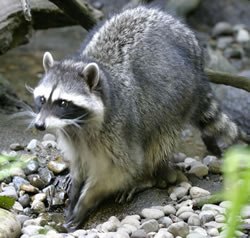Every night, Elizabeth Schermerhorn lets her three and a half-pound Yorkshire terrier Rosie outside for a few minutes to go to the bathroom in their fenced-in yard, located in the North Beach neighborhood. But several weeks ago, Schermerhorn let Rosie into the backyard and just moments later heard the dog shrilly barking in what she could only describe as a scream.
“The warning bells went off in my head and everything happened so quickly,” said Schermerhorn, who remembers running outside and seeing a large raccoon on top of her dog. Her husband, who also heard the noises, came out and scared the raccoon away. Rosie was left with puncture wounds on her back and leg. And the Schermerhorns were left unsure who to call or what to do. Luckily, they have a friend with a medical background, who cleaned the wounds and they called a vet in the morning.
A week after the Schermerhorns’ dog was attacked, another resident in the same neighborhood said her cat was attacked and injured by six raccoons.
“I couldn’t scare them away,” said Patricia Tullock. “It was so scary, I’ve never seen so many before.”
The injured pets are both recovering, but sounds of other animals being attacked in the night, have left the two women worried about what the raccoons might do next and what they should do if there is another attack.
Although San Juan County does not have an animal control sector the Sheriff’s Office does handle problems, which “typically involve dog behavior- barking, biting, running at large, chasing or injuring/killing livestock, menacing people,” said Sheriff Rob Nou. “On issues like raccoon attacks and/ or problems, we can solicit help from Fish and Wildlife to try to trap and relocate offending critters.”
But Shona Aitken, education coordinator at Wolf Hollow Wildlife Rehabilitation Center, said removing problem animals does not solve the problem.
“If you remove raccoons it creates an open space and other raccoons will move in,” she said.
Adult raccoons weigh 15 to 40 pounds, their weight being a result of genetics, age, available food, and habitat location. Males have weighed in at over 60 pounds. The average life span of a raccoon in the wild is two to three years. As long as raccoons are kept out of human homes, not cornered, and not treated as pets, they are not dangerous, according to the Washington Department of Fish and Wildlife.
Raccoon populations can get quite large in urban areas, due to hunting and trapping restrictions, few predators, and human-supplied food, according to the USFWS’s website.
Aitken said raccoons often become a problem when they have been regularly fed by humans or when someone who has fed them for ages suddenly stops. “Then there are a bunch of raccoons with youngsters getting desperate because their usual source of food has disappeared,” she said. “Anyone who has been regularly feeding animals such as raccoons for a long time, should discontinue, very gradually, over the period of several months.”
Another reason for an increase in raccoon activity in residential areas may be the recent spell of hot, dry weather, said Aitken, which makes it more difficult for them to find sources of fresh water and juicy food, so yards look even more tempting than usual.
And the North Beach area may be enticing because raccoons love to eat clams, crayfish, frogs, fish, and snails.
This is also baby season, so mom “can be protective of her young … and take risks they would not otherwise consider,” Shona added.
Aitken said that the best way to deal with raccoons is to make sure they are not enticed to come onto your property. This can be accomplished in a few steps:
1: Spray your yard and deck with unpleasant scents like coyote urine (available for purchase online), lemon juice or vinegar. If you see raccoons on your yard, spray them with a hose to show them they are not welcome. Installing motion sensors for lights or sprinklers also dissuades the animals from coming near your home.
2: Keep compost, garbage and other food contained. Do not leave your pet food outdoors.
3: Keep pets inside. Dogs and cats can be attacked by a range of wildlife.
Aitken said there is no record of any reported cases of rabies in mammals on the islands, but that doesn’t mean people should not be concerned about wildlife.
“Pet interactions with wildlife happen all the time,” Aitken said. “We feel like we are safe because we don’t have large predators, but it’s a false sense of security.”
Schermerhorn, who has spent a lot of time researching raccoons online, now only lets her dog out on a leash and double checks her trash so there is no food to attract the raccoons.
“I don’t dislike raccoons, I know they are wild animals and hungry or defending their territory,” she said. “I just think people need to take precautions.”
Aitken said people are welcome to call Wolf Hollow if they have questions or concerns about wildlife.
You can also call the WDFW Regional Office at 425-775-1311.
To learn more about preventing conflicts with raccoons visit http://wdfw.wa.gov/living/raccoons.html.



